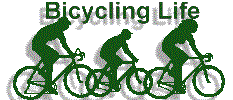POLICE PUBLIC MEMO
From: Chief J.W. Rittenhouse, Charlottesville
Police Chief
Michael Sheffield, Univ. of Virginia
Police Chief John
Miller, Albemarle County Police
Charlottesville-Albemarle
Bicycling Assoc. (CHABA)
Clarification of existing traffic laws for motorists and bicyclists.
Motorists: Bicyclists are by law allowed a full traffic
lane whenever needed.
“Every person riding a bicycle... shall have all of the rights... applicable to
the driver of a vehicle.” “Any person operating a bicycle ... shall ride as
close as practicable to the right ....
EXCEPT when passing ... turning ... when reasonably necessary to avoid
conditions not limited to fixed or moving objects, moving or parked vehicles, pedestrians,
animals, surface hazards, or substandard width lanes ... too narrow for a bicycle and
another vehicle to pass safely side by side within the lane.”
“In passing a bicycle ... the driver of a motor vehicle shall pass at a safe
distance and reasonable speed.”
(Va. State Motor Vehicle Code 46.2-800, 46.2-905, 46.2-837)
Traffic law never requires bicyclists to “squeeze over”. Bicyclists need to
merge and take a full lane when approaching narrow lanes or other possible hazards. This
rarely slows motorists by more than 20-30 seconds. Motorists who “squeeze past”
are endangering bicyclists, and other road users as well. Always leave a generous space
cushion around bicyclists and pedestrians. It is their only protection.
Bicyclists: Obey vehicular rules for your own safety and
freedom.
Every road user, motorist or bicyclist, is responsible for operating by vehicular
rules, and for going no faster than the posted speed limit. Nobody is safe when someone
nearby is ignoring these rules or making up their own.
Vehicular Cycling is bicycling in traffic by predictable vehicular rules, instead of
darting around like a squirrel. Studies show that Vehicular Cyclists are safer than people
in cars, and can avoid 95% of accidents that occur to other cyclists.
Much more than just signaling turns, Vehicular Cycling is keeping a straight line. It
is moving sideways by merging across the lane, exactly the same way a car changes lanes.
It is “creating a space cushion around your vehicle” (DMV) - riding about 4 ft.
away from parked cars, curbs, debris, etc. Most importantly, it is "Taking The
Full Lane" on narrow roads, in narrow traffic lanes, or when any possible hazard is
ahead. This makes the cyclist much more noticeable, prevents motorists from
“squeezing past”, and creates a space cushion in case they try. (see Bicycle
Drivers Manual on the web.
Everyone has equal rights on public roads. Roads are shared, public facilities.
“Look for bicycles on all public roads ... Bicycles are considered vehicles and
have the same rights-of-way ... The rider will use the entire lane as traffic situations
and road conditions change.” “In rural areas, adjust your speed for hills,
curves ... bicyclists, and other slow-moving vehicles. By law, you must drive slower ...
these conditions make the posted speed unsafe. It is your responsibility to adjust your
driving to assure everyones’ safety." "In other words, SLOW DOWN." (Va.
State Drivers Manual)
Public roads have always been shared by different types and speeds of vehicles. In US
history, paving roads began at bicyclists’ request back when cars were slower and
experimental. Everyone, without exception, has the right to use and be safe on all public
roads. However, people who operate dangerous high-speed machinery (motor-vehicles) on
public roads frequently cause massive damage and injury to others. That is why they are
licensed and insured.
